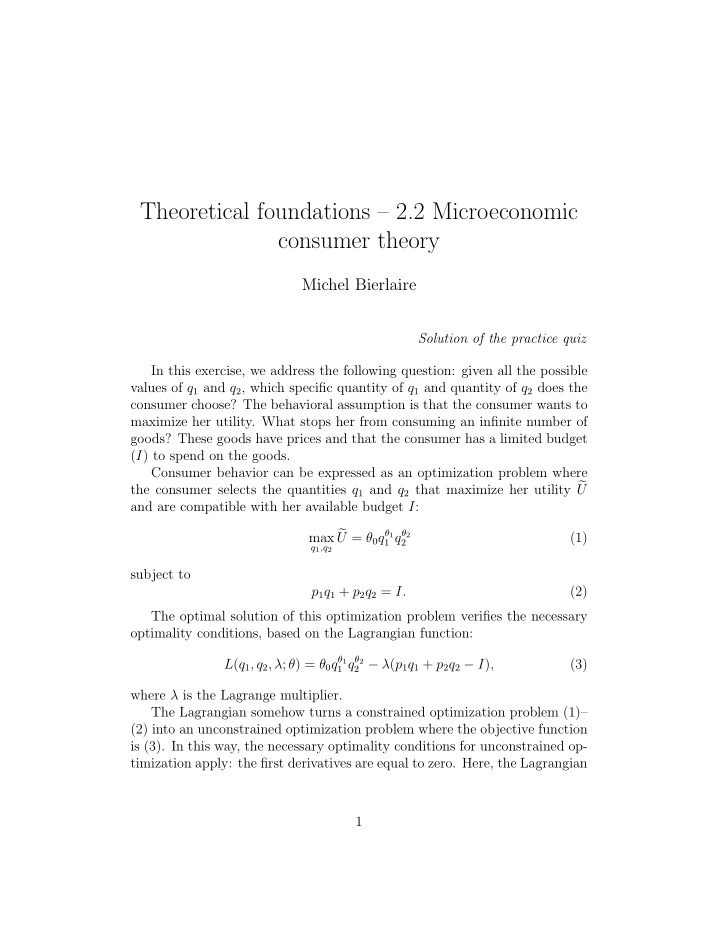



Theoretical foundations – 2.2 Microeconomic consumer theory Michel Bierlaire Solution of the practice quiz In this exercise, we address the following question: given all the possible values of q 1 and q 2 , which specific quantity of q 1 and quantity of q 2 does the consumer choose? The behavioral assumption is that the consumer wants to maximize her utility. What stops her from consuming an infinite number of goods? These goods have prices and that the consumer has a limited budget ( I ) to spend on the goods. Consumer behavior can be expressed as an optimization problem where the consumer selects the quantities q 1 and q 2 that maximize her utility � U and are compatible with her available budget I : U = θ 0 q θ 1 � 1 q θ 2 max (1) 2 q 1 ,q 2 subject to p 1 q 1 + p 2 q 2 = I. (2) The optimal solution of this optimization problem verifies the necessary optimality conditions, based on the Lagrangian function: L ( q 1 , q 2 , λ ; θ ) = θ 0 q θ 1 1 q θ 2 2 − λ ( p 1 q 1 + p 2 q 2 − I ) , (3) where λ is the Lagrange multiplier. The Lagrangian somehow turns a constrained optimization problem (1)– (2) into an unconstrained optimization problem where the objective function is (3). In this way, the necessary optimality conditions for unconstrained op- timization apply: the first derivatives are equal to zero. Here, the Lagrangian 1
has three unknowns: q 1 , q 2 and the Lagrange multiplier λ . Therefore, ∂L/∂q 1 = θ 0 θ 1 q θ 1 − 1 q θ 2 2 − λp 1 = 0 , (4) 1 ∂L/∂q 2 = θ 0 θ 2 q θ 1 1 q θ 2 − 1 − λp 2 = 0 , (5) 2 ∂L/∂λ = p 1 q 1 + p 2 q 2 − I = 0 . (6) Multiplying (4) by q 1 and (5) by q 2 , we have θ 0 θ 1 q θ 1 1 q θ 2 2 − λp 1 q 1 = 0 , (7) θ 0 θ 2 q θ 1 1 q θ 2 2 − λp 2 q 2 = 0 . (8) Adding the two and using (6) we obtain λI = θ 0 q θ 1 1 q θ 2 2 ( θ 1 + θ 2 ) (9) or, equivalently, λI θ 0 q θ 1 1 q θ 2 2 = ( θ 1 + θ 2 ) . (10) Using (10) in (7), we obtain λp 1 q 1 λI = ( θ 1 + θ 2 ) . (11) θ 1 Solving (11) for q 1 , we obtain θ 1 I q ∗ 1 = . (12) ( θ 1 + θ 2 ) p 1 Similarly, we obtain θ 2 I q ∗ 2 = . (13) ( θ 1 + θ 2 ) p 2 The Cobb-Douglas function has the property that the demand for a good is only dependent on its own price and independent of the price of any other good, which is a fairly restrictive assumption. The equations can also be solved for the third unknown, the Lagrange multiplier λ : � � θ 1 � � θ 2 I ( θ 1 + θ 2 − 1) θ 1 θ 2 λ = θ 0 ( θ 1 + θ 2 ) (14) p θ 1 1 p θ 2 θ 1 + θ 2 θ 1 + θ 2 2 2
The parameter λ is not just a nuisance parameter but has a useful inter- pretation. Its value is the marginal utility of income, that is the increase in utility that results if income is increased by one unit. Equivalently, λ is equal to the marginal utility of good ℓ ( ∂ � U/∂q ℓ ) divided by the marginal cost of good ℓ (equal to p ℓ in this example) for all goods, or λ = ∂ � U/∂q ℓ for all goods ℓ. (15) p ℓ The above equation is directly derived from (4) and (7), that can be written as ∂L/∂q ℓ = ∂ ˜ U/∂q ℓ − λp ℓ = 0 . (16) Equation (15) is often described as an optimality condition. Concep- tually, at optimal consumption each good should yield the same marginal utility per monetary unit spent. At optimality, if given one extra unit of income to spend, the consumer is indifferent as to which good to purchase more. If the consumer is not indifferent, then she was not at optimality and should adjust her consumption bundle towards the preferred good. The op- timality conditions can also be rearranged to state that the marginal rate of substitution of good i for good j is equal to the ratio of the marginal costs of good i relative to good j . For the two commodity case and linear budget constraint, this optimality condition is obtained by calculating the ratio of (15) for ℓ = 1 and ℓ = 2 as ∂ � U/∂q 1 = p 1 . (17) ∂ � p 2 U/∂q 2 3
Recommend
More recommend